1994 CADILLAC SEVILLE tire pressure
[x] Cancel search: tire pressurePage 193 of 399

Downloaded from www.Manualslib.com manuals search engine Here’s how anti-lock works. Let’s say the road is wet. You’re driving
safely. Suddenly an animal jumps out in front of you.
You slam on the brakes. Here’s what happens with
ABS.
A computer senses that wheels are slowing down. If one of the wheels is
about
to stop rolling, the computer will separately work the brakes at
each front wheel and at the rear wheels.
The anti-lock system can change the brake pressure faster than any driver
could. The computer is programmed to make the most of available tire
and road conditions.
You can steer around the obstacle while braking hard.
180
Page 204 of 399
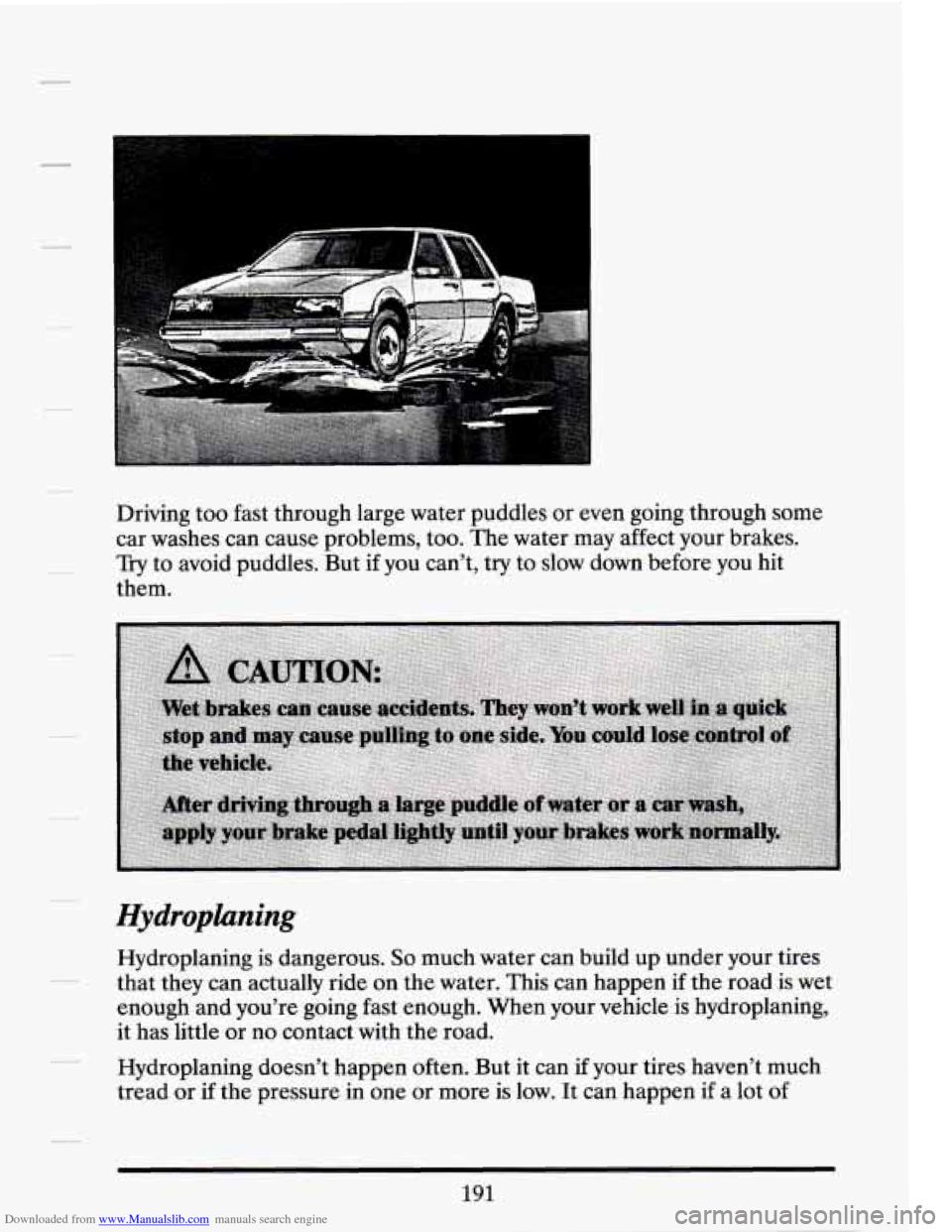
Downloaded from www.Manualslib.com manuals search engine Driving too fast through large water puddles or even going through some
car washes can cause problems, too. The water may affect your brakes.
Try to avoid puddles. But if you can’t, try to slow down before you hit
them.
Hydroplaning
Hydroplaning is dangerous. So much water can build up under your tires
that they can actually ride on the water. This can happen if the road
is wet
enough and you’re going fast enough. When your vehicle is hydroplaning,
it has little or no contact with the road.
Hydroplaning doesn’t happen often. But it can
if your tires haven’t much
tread or
if the pressure in one or more is low. It can happen if a lot of
Page 208 of 399
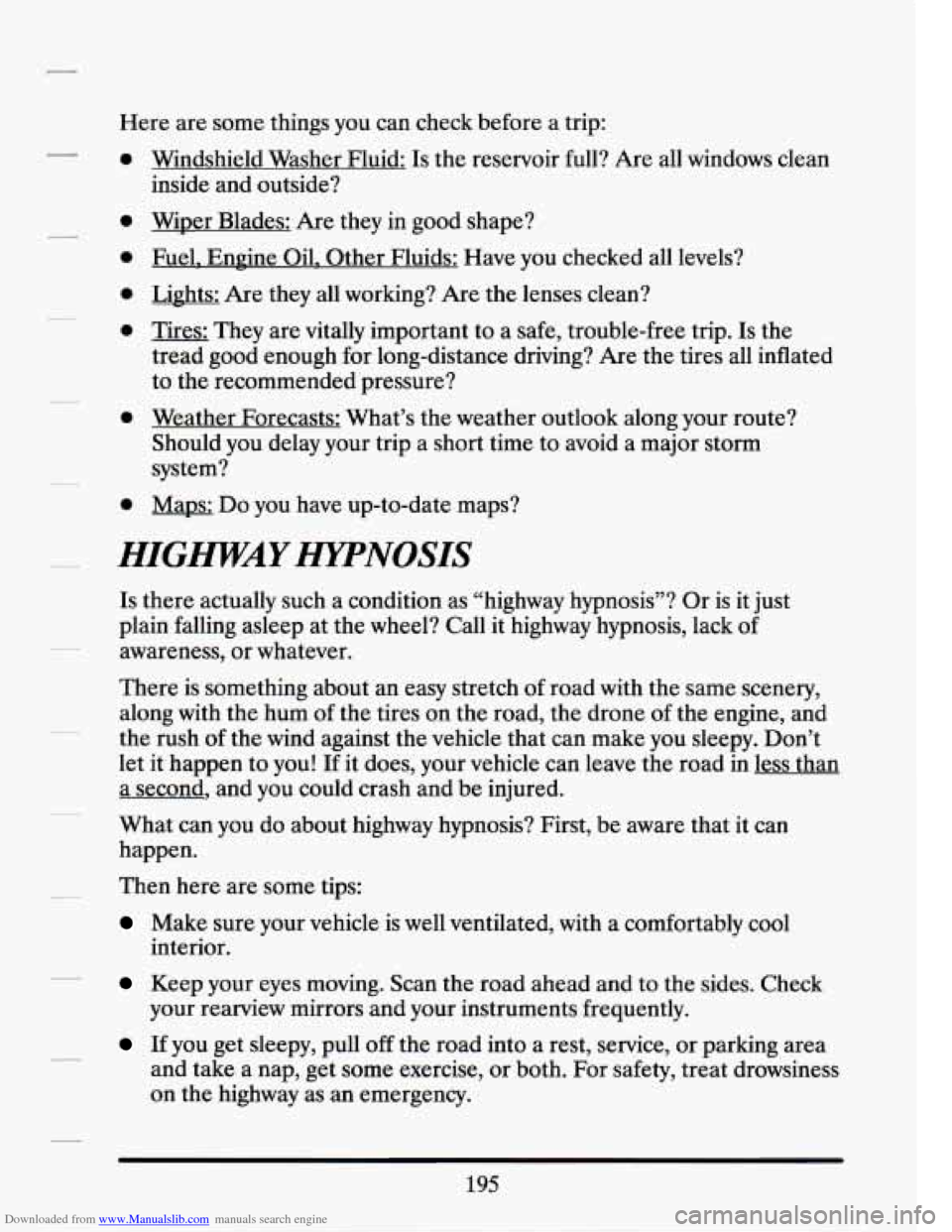
Downloaded from www.Manualslib.com manuals search engine Here are some things you can check before a trip:
0
0
0
0
0
e
0
Windshield Washer Fluid: Is the reservoir full? Are all windows clean
inside and outside?
Wiper Blades:
Are they in good shape?
Fuel. Engine Oil, Other Fluids; Have you checked all levels?
Lichts:
Are they all working? Are the lenses clean?
Tires: They are vitally important to a safe, trouble-free trip.
Is the
tread good enough for long-distance driving? Are the tires all inflated
to the recommended pressure?
Weather Forecasts: What’s the weather outlook along your route?
Should you delay your trip a short time to avoid a major storm
system?
Maps:
Do you have up-to-date maps?
HIGmAY HITNOSIS
Is thh Actually such a condition as “highway hypnosis”? Or is it just
plain falling asleep at the wheel? Call it highway hypnosis, lack
of
awareness, or whatever.
There is something about an easy stretch
of road with the same scenery,
along with the hum
of the tires on the road, the drone of the engine, and
the rush
of the wind against the vehicle that can make you sleepy. Don’t
let it happen to you!
If it does, your vehicle can leave the road in less than
a second, and you could crash and be injured.
What can you do about highway hypnosis? First, be aware that it can
happen.
Then here are some tips:
Make sure your vehicle is well ventilated, with a comfortably cool
interior.
Keep your eyes moving. Scan the road ahead and to the sides. Check
your rearview mirrors and your instruments frequently.
If you get sleepy, pull off the road into a rest, service, or parking area
and take a nap, get some exercise, or both. For safety, treat drowsiness
on the highway as an emergency.
195
Page 244 of 399

Downloaded from www.Manualslib.com manuals search engine 5. Then replace the
pressure cap. Be
sure the arrows on
the pressure cap
line up
like this.
Start the engine and allow it to warm up. If the “ENGINE COOLANT
LOW” message does not appear on the Driver Information Center,
coolant is at the proper fill level. If an “ENGINE COOLANT
LOW”
message does appear, repeat steps 1 to 3 or see your dealer.
IF A TIRE GOES FLAT
It’s unusual for a tire to “blow out” while you’re driving, especially if you
maintain your tires properly. If air goes out of a tire, it’s much more likely
to leak out slowly. But
if you should ever have a “blowout,” here are a
few tips about what to expect and what to do:
If a front tire fails, the flat tire will create a drag that pulls the vehicle
toward that side. Take your foot
off the accelerator pedal and grip the
steering wheel firmly. Steer
to maintain lane position, then gently brake
to a stop well out of the traffic lane.
A rear blowout, particularly on a curve, acts much like a skid and may
require the same correction you’d use in a skid. In any rear blowout,
remove your foot from the accelerator pedal. Get the vehicle under
control by steering the way you want the vehicle to go. It may be
very
bumpy and noisy, but you can still steer. Gently brake to a stop, well off
the road if possible.
If a tire goes flat, the next section shows how to use your jacking
equipment to change a flat tire safely.
Page 253 of 399
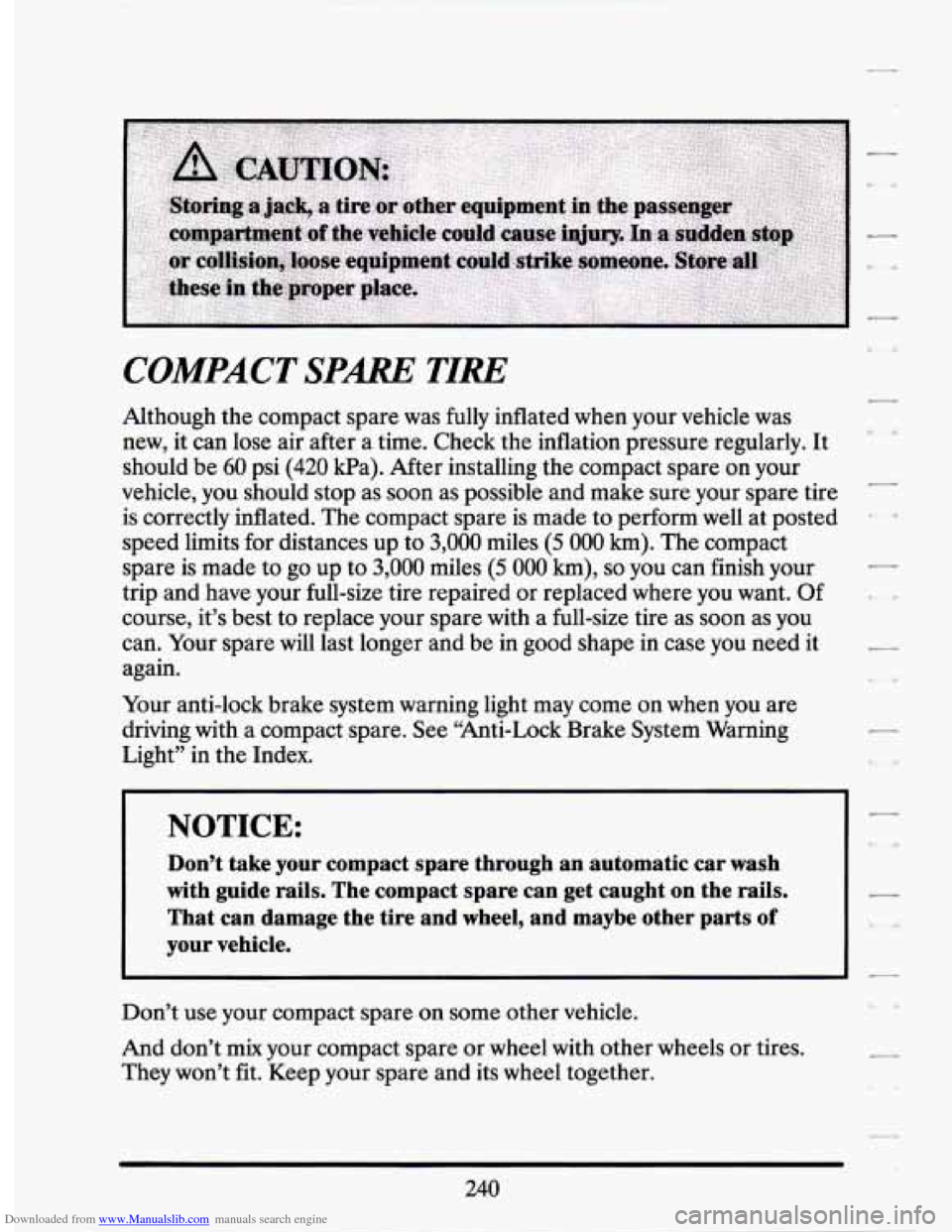
Downloaded from www.Manualslib.com manuals search engine COMPACT SPARE TIRE
Although the compact spare was fully inflated when your vehicle was
new, it can lose air after a time. Check the inflation pressure regularly. It
should be
60 psi (420 Wa). After installing the compact spare on your
vehicle, you should stop as soon as possible and make sure your spare tire
is correctly inflated. The compact spare is made to perform well at posted
speed limits for distances up to
3,000 miles (5 000 km). The compact
spare is made to go up to
3,000 miles (5 000 km), so you can finish your
trip and have your full-size tire repaired or replaced where you want. Of
course, it’s best to replace your spare with a full-size tire as soon as you
can. Your spare will last longer and be
in good shape in case you need it
again.
Your anti-lock brake system warning light may come on when you are
driving with a compact spare. See “Anti-Lock Brake System Warning
Light”
in the Index.
NOTICE:
Don’t take your compact spare through an automatic car wash \
with guide rails. The compact spare can get caught on the rails.
That can damage the tire and wheel, and maybe other parts
of
your vehicle.
Don’t use your compact spare on some other vehicle.
And don’t
mix your compact spare or wheel with other wheels or tires.
They won’t fit. Keep your spare and its wheel together.
7
240
Page 260 of 399
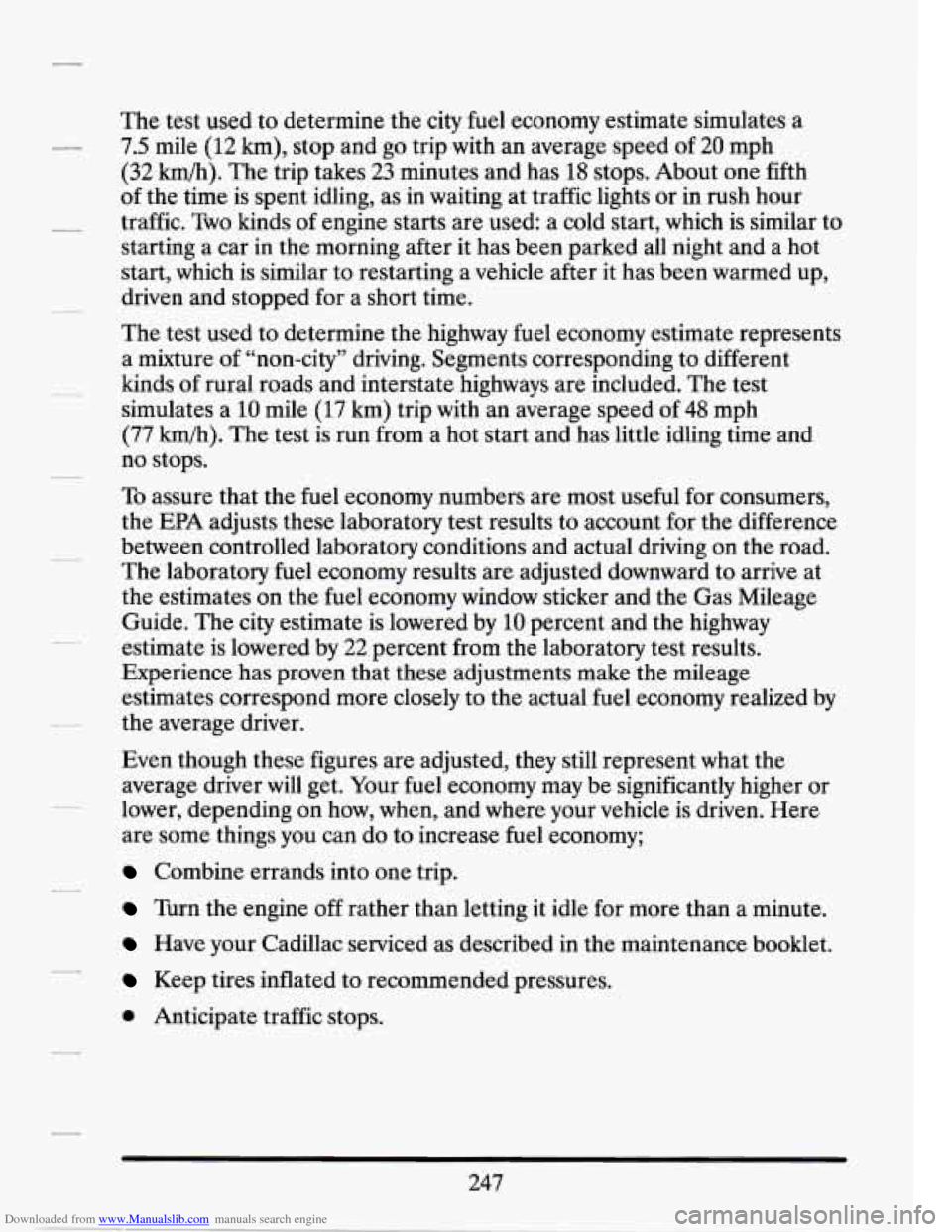
Downloaded from www.Manualslib.com manuals search engine -
The test used to determine me city fuel economy estimate simulates a
7.5 mile
(12 km), stop and go trip with an average speed of 20 mph
(32 km/h). The trip takes 23 minutes and has 18 stops. About one fifth
of the time is spent idling, as in waiting at traffic lights or in rush hour
traffic. Two kinds
of engine starts are used: a cold start, which is similar to
starting a car in the morning after it has been parked all night and a hot
start, which is similar to restarting
a vehicle after it has been warmed up,
driven and stopped for a short time.
The test used to determine the highway fuel economy estimate represents
a mixture
of “non-city” driving. Segments corresponding to different
kinds of rural roads and interstate highways are included. The test
simulates a
10 mile (17 km) trip with an average speed of 48 mph
(77
km/h). The test is run from a hot start and has little idling time and
no stops.
To assure that the fuel economy numbers are most useful for consumers,
the EPA adjusts these laboratory test results to account for the difference
between controlled laboratory conditions and actual driving on the road.
The laboratory fuel economy results are adjusted downward to arrive at
the estimates on the fuel economy window sticker and the Gas Mileage
Guide. The
city estimate is lowered by 10 percent and the highway
estimate is lowered by
22 percent from the laboratory test results.
Experience has proven that these adjustments make the mileage
estimates correspond more closely to the actual fuel economy realized by
the average driver.
Even though these figures are adjusted, they still represent what the
average driver will get. Your fuel economy may be significantly higher or
lower, depending on how, when, and where your vehicle is driven. Here
are some things you can do to increase fuel economy;
Combine errands into one trip.
Turn the engine off rather than letting it idle for more than a minute.
Have your Cadillac serviced as described in the maintenance booklet.
Keep tires inflated to recommended pressures.
0 Anticipate traffic stops.
247
Page 300 of 399
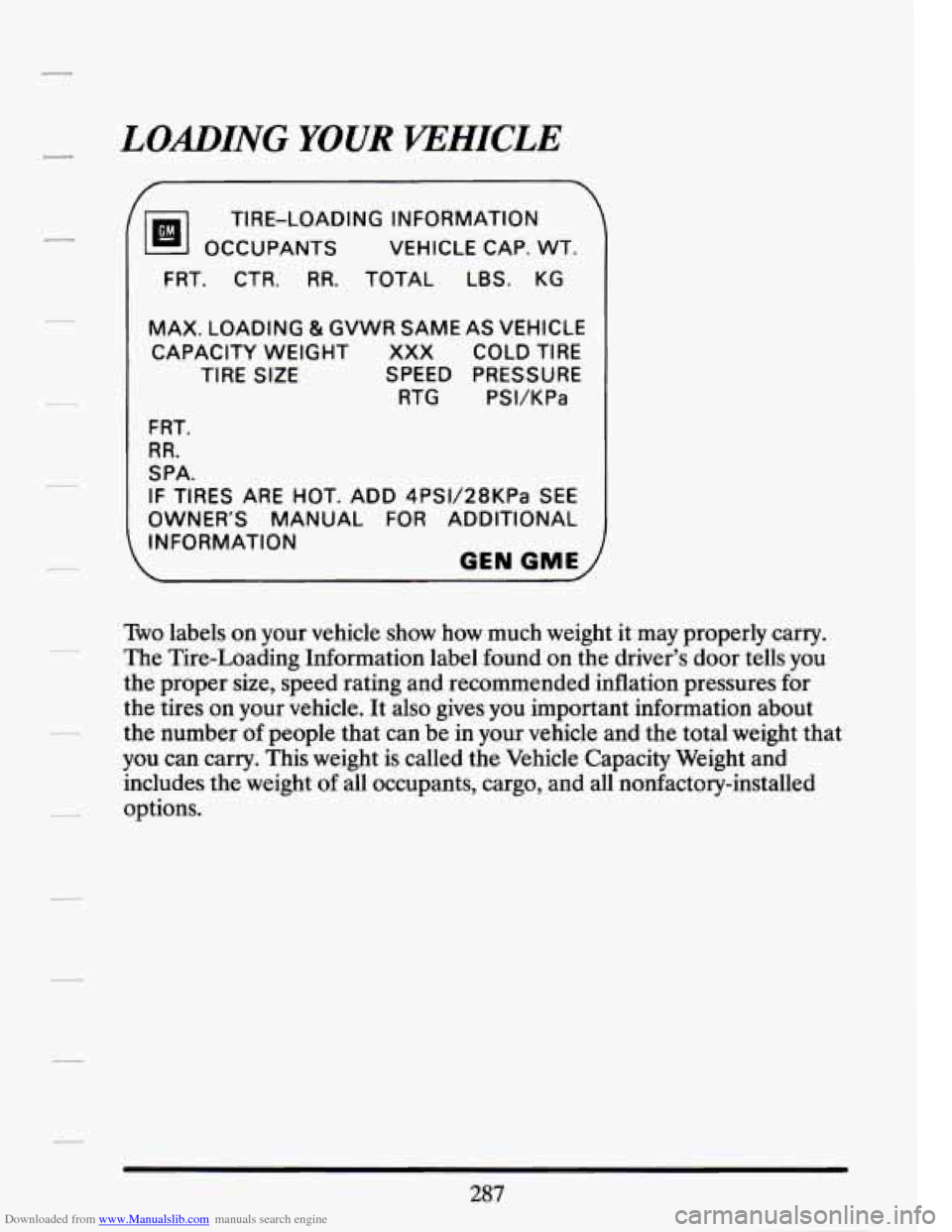
Downloaded from www.Manualslib.com manuals search engine LOADING YOUR VEHICLE
TIRE-LOADING INFORMATION
OCCUPANTS VEHICLE CAP. WT.
FRT. CTR.
RR. TOTAL LBS. KG
MAX. LOADING & GVWR SAME AS VEHICLE
CAPACITY WEIGHT XXX COLD TIRE
TIRE SIZE SPEED PRESSURE RTG PSI/KPa
F RT.
R R.
SPA.
IF TIRES ARE HOT. ADD 4PSV28KPa SEE
OWNER'S MANUAL FOR ADDITIONAL
GEN GM.E \'NFoRMAT1oN
Two labels on your vehicle show how much weight it may properly carry.
The Tire-Loading Information label found on the driver's door tells you
the proper
size, speed rating and recommended inflation pressures for
the tires on your vehicle. It also gives you important information about
the number of people that can be in your vehicle and the total weight that
you can carry. This weight is called the Vehicle Capacity Weight and
includes the weight
of all occupants, cargo, and all nonfactory-installed
options.
287
Page 303 of 399

Downloaded from www.Manualslib.com manuals search engine Infition - Tire Pressure
The Tire-Loading Information label which is shows the correct inflation
pressures for your tires, when they’re cold. “Cold” means your vehicle has
been sitting
for at least three hours or driven no more than a mile.
SLS (270 hp)
If you’ll be driving at speeds higher than 100 mph (160 km/h) where it is
legal, raise the “cold” inflation pressure
of each tire to 35 psi (240 kPa).
When you end this
very high speed driving, reduce the “cold” inflation
pressures to those listed
on the Tire-Loading Information label.
290
LY